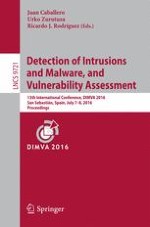This book constitutes the refereed proceedings of the 13th International Conference on Detection of Intrusions and Malware, and Vulnerability Assessment, DIMVA 2016, held in San Sebastián, Spain, in July 2016.
The 19 revised full papers and 2 extended abstracts presented were carefully reviewed and selected from 66 submissions. They present the state of the art in intrusion detection, malware analysis, and vulnerability assessment, dealing with novel ideas, techniques, and applications in important areas of computer security including vulnerability detection, attack prevention, web security, malware detection and classification, authentication, data leakage prevention, and countering evasive techniques such as obfuscation.

